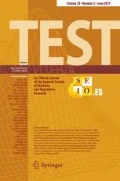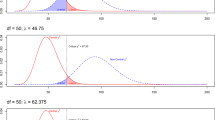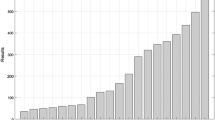Abstract
Linear mixed models have been frequently used to provide estimates in small areas. However, when aggregating small areas within the same region, the sum of these small area estimates does not generally match up with the estimate obtained using an appropriate estimator for the larger region. Then, benchmarking the model-dependent estimates to the ones obtained at certain level of aggregation is needed. In this paper, we propose a small area estimator based on a linear mixed effects model with restrictions to guarantee the concordance between the aggregations of small area estimates and those reported by statistical agencies for larger domains using a synthetic estimator. The mean squared prediction error of the restricted estimator is also derived and its performance is evaluated through a simulation study. The procedure is applied to the 2002 Business Survey of the Basque Country, Spain.
Similar content being viewed by others
References
Butar FB, Lahiri P (2003) On measures of uncertainty of empirical Bayes small-area estimators. J Stat Plan Inference 112:63–76
Cholette PA, Dagum EB (1994) Benchmarking time series with autocorrelated survey errors. Int Stat Rev 62:365–377
Chen ZG, Wu KH (2006) Comparison of benchmarking methods with and without a survey error model. Int Stat Rev 74:285–304
Demidenko E (2004) Mixed models. Theory and applications. Wiley, New York
Durbin J, Quenneville B (1997) Benchmarking by state space models. Int Stat Rev 65:23–48
Fay RR, Herriot R (1979) Estimates of income for small places: an application of James-Stein procedures to census data. J Am Stat Assoc 74:269–277
Golfeld M, Quandt RE (1972) Nonlinear methods in econometrics. North Holland, Amsterdam
González-Manteiga W, Lombardía MJ, Molina I, Morales D, Santamaría L (2008) Bootstrap mean squared error of a small-area EBLUP. J Stat Comput Simul (in press)
Hall P, Maiti T (2006) On parametric bootstrap methods for small area prediction. J R Stat Soc Ser B 68:221–238
Hillmer SC, Trabelsi A (1987) Benchmarking of economic times series. J Am Stat Assoc 82:1064–1071
Jiang J, Lahiri P (2006) Mixed model prediction and small area estimation (with discussion). Test 15:1–96
Lahiri P (2003) On the impact of bootstrap in survey sampling and small-area estimation. Stat Sci 18: 199–210
Militino AF, Ugarte MD, Goicoa T (2007) A BLUP synthetic versus an EBLUP estimator: an empirical study of a small area estimation problem. J Appl Stat 34:153–165
Pfeffermann D (1984) On extensions for the Gauss–Markov theorem to the case of stochastic regression coefficients. J R Stat Soc Ser B 46:139–148
Pfeffermann D (2002) Small area estimation. New developments and directions. Int Stat Rev 70:125–143
Pfeffermann D, Barnard CH (1991) Some new estimators for small-area means with application to the assessment of farmland values. J Bus Econ Stat 9:73–84
Pfeffermann D, Tiller R (2005) Bootstrap approximation to prediction MSE for state-space models with estimated parameters. J Time Ser Anal 26:893–916
Pfeffermann D, Tiller R (2006) Small area estimation with state space models subject to benchmark constraints. J Am Stat Assoc 401:1387–1397
Prasad NGN, Rao JNK (1990) The estimation of mean squared error of small area estimators. J Am Stat Assoc 85:163–171
Rao JNK (2003) Small area estimation. Wiley, New York
Royall RM (1976) The linear least squares prediction approach to two-stage sampling. J Am Stat Assoc 71:657–664
Searle SR, Casella G, McCullogh CE (1992) Variance components. Wiley, New York
Stukel DM (1991) Small area estimation under one and two-fold nested error regression model. PhD Thesis, Carleton University
Theil H (1971) Principles of econometrics. Wiley, New York
Valliant R, Dorfman AH, Royall RM (2000) Finite population sampling and inference. Wiley, New York
Wu CFJ (1986) Jacknife, bootstrap and other resampling methods in regression analysis (with discussion). Ann Stat 14:1261–1350
You Y, Rao JNK, Dick P (2004) Benchmarking hierarchical Bayes small area estimators in the Canadian census undercoverage estimation. Stat Transit 6:631–640
Author information
Authors and Affiliations
Corresponding author
Rights and permissions
About this article
Cite this article
Ugarte, M.D., Militino, A.F. & Goicoa, T. Benchmarked estimates in small areas using linear mixed models with restrictions. TEST 18, 342–364 (2009). https://doi.org/10.1007/s11749-008-0094-x
Received:
Accepted:
Published:
Issue Date:
DOI: https://doi.org/10.1007/s11749-008-0094-x




